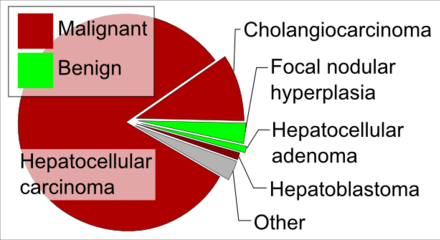Liver Cancer
Liver cancer, also known as hepatic cancer, primary hepatic cancer, or primary hepatic malignancy, is a type of cancer that originates in the liver. It can be classified as primary liver cancer, which starts in the liver, or secondary liver cancer, or liver metastasis, which spreads to the liver from other parts of the body. Primary liver cancer is the sixth most frequent cancer globally and the fourth leading cause of cancer deaths.

Signs and Symptoms
Liver cancer symptoms can be vague and broad, depending on the type. Common symptoms include a lump or pain in the right side below the rib cage, swelling of the abdomen, jaundice (yellowish skin), easy bruising, weight loss, and weakness.
Cholangiocarcinoma is associated with sweating, jaundice, abdominal pain, weight loss, and liver enlargement, whereas hepatocellular carcinoma (HCC) is associated with abdominal mass, abdominal pain, vomiting, anaemia, back pain, jaundice, itching, weight loss, and fever.
Diagnosis
The diagnosis of liver cancer involves a combination of blood tests, medical imaging, and tissue biopsy. Imaging modalities such as ultrasound, CT, and MRI are frequently used. High levels of alpha-fetoprotein (AFP) in the blood can be indicative of HCC and intrahepatic cholangiocarcinoma.
Cholangiocarcinoma can be detected with tumour markers like CA 19–9, CEA, and CA125. For those at risk, screening with ultrasound every six months is recommended.
Causes
Liver cancer is primarily caused by cirrhosis due to hepatitis B, hepatitis C, or alcohol use. Other causes include aflatoxin exposure, non-alcoholic fatty liver disease, and liver flukes.

Viral Infection
Hepatitis B virus (HBV) and hepatitis C virus (HCV) are the chief causes, accounting for 80% of HCC cases. Chronic infection with these viruses leads to significant liver inflammation, fibrosis, and cirrhosis, increasing cancer risk.
Cirrhosis
Cirrhosis, whether virus-related or due to alcohol abuse, significantly increases the risk of HCC. Other causes include hereditary hemochromatosis and primary biliary cirrhosis.

Aflatoxin
Aflatoxin, produced by fungi Aspergillus flavus and A. parasiticus, contaminates foodstuffs like cereals and peanuts, especially in Africa and Asia. Exposure leads to mutations that increase cancer risk.
Prevention
Preventive measures include immunisation against hepatitis B, treating hepatitis B and C, reducing alcohol consumption, avoiding aflatoxin exposure, and managing obesity and diabetes. Screening high-risk individuals with chronic liver disease is also recommended.
Treatment
General Considerations
Treatment depends on the type and stage of liver cancer, with options including surgery, targeted therapy, and radiation therapy. For HCC, partial surgical resection or liver transplantation are common. Percutaneous ablation, which uses chemicals or temperature extremes to destroy cancer cells, is another option.

Hepatocellular Carcinoma
Surgical resection and liver transplantation are primary treatments. Percutaneous ablation and transarterial chemoembolisation (TACE) are used when surgery isn’t viable. Sorafenib, a targeted drug, shows benefits in advanced HCC.

Intrahepatic Cholangiocarcinoma
Surgery is often not an option due to multiple focal tumours. Photodynamic therapy improves quality of life and survival in un-resectable cases. Systemic chemotherapies like gemcitabine and cisplatin are also used.

Hepatoblastoma
Hepatoblastoma, primarily affecting children, is treated with surgery or liver transplant. Chemotherapy options include cisplatin, vincristine, cyclophosphamide, and doxorubicin.
Epidemiology
Liver cancer is increasing globally, with the highest rates in Northern and Western Africa, and Eastern and South-Eastern Asia. China accounts for 50% of HCC cases. In the US, there were 42,810 new cases in 2020, with a 5-year survival rate of 19.6%.

Self-assessment MCQs (single best answer)
Which of the following is NOT a common symptom of hepatocellular carcinoma (HCC)?
What is the primary cause of liver cancer globally?
Which diagnostic marker is indicative of hepatocellular carcinoma (HCC)?
What is a primary preventive measure for liver cancer?
Which treatment is commonly used for advanced hepatocellular carcinoma (HCC)?
What type of liver cancer is most likely in children?
What is a common imaging modality used in the diagnosis of liver cancer?
What is a significant risk factor for developing liver cancer due to cirrhosis?
Which region has the highest incidence of liver cancer cases?
Which of the following is NOT a common treatment option for intrahepatic cholangiocarcinoma?
Dentaljuce
Dentaljuce provides Enhanced Continuing Professional Development (CPD) with GDC-approved Certificates for dental professionals worldwide.
Founded in 2009 by the award-winning Masters team from the School of Dentistry at the University of Birmingham, Dentaljuce has established itself as the leading platform for online CPD.
With over 100 high-quality online courses available for a single annual membership fee, Dentaljuce offers comprehensive e-learning designed for busy dental professionals.
The courses cover a complete range of topics, from clinical skills to patient communication, and are suitable for dentists, nurses, hygienists, therapists, students, and practice managers.
Dentaljuce features Dr. Aiden, a dentally trained AI-powered personal tutor available 24/7 to assist with queries and provide guidance through complex topics, enhancing the learning experience.
Check out our range of courses, or sign up now!


